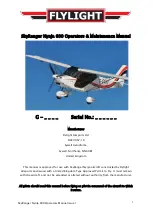
Puma 13.5
Owner’s Manual
the rigging sequence.) Insert the other battens working from the tip towards the centre root of the sail.
On a new glider a little silicon spray on the batten ends will help them slide in smoothly. Keeping the
trailing edge low and slowly easing the battens into their respective pockets will help increase batten
pocket and sail life. If the batten will not slide easily into the pocket, move the sail and try again. Do
not force the battens in as it may damage the batten pocket Do not tension the battens at this stage.
9. The glider can now be tensioned: First make sure the side wires are not caught around the battens. Then
remove the split ring from the special bolt located through the rear of the keel tube. Using the attached
cords initially and then holding the webbing, pull the cross tube restraint webbing back. Check that the
cords are not twisted. Locate the stainless tang over the stub of the bolt and slide into location closest to
the keel. Now take the rear top wire (from the kingpost), place tang onto bolt stub and replace the split
ring. PUT THE RING IN IMMEDIATELY. DO NOT LEAVE IT UNTIL LATER. If the tension feels
too tight stop and see what is causing the problem. DO NOT JUST FORCE IT. (Consult the trouble
shooting area of this manual for possible causes.)
Figure 1: Tensioning the glider
10. Push the battens home the last little bit. With a new sail the battens may need a little push to go fully
home. The batten ends can then be snapped closed. The snap battens all snap closed outwards. Do not
alter the tension of the snap batten ends by turning the fitting. (unless intentionally adjusting batten
tension, see tuning section)
11. The compression strut (batten No 10) nearest the wing tip can only be inserted when the glider has been
tensioned. It slides into its batten pocket and the front end locates on a plastic cleat on the leading edge.
This batten or compression strut is profiled on the Puma. Like all the other top surface battens the curve
should be up. (The top surface of the wing should be convex, not concave). Left and right compression
struts can be identified for the direction of the clippy end. All battens release inwards and snap closed
outwards (i.e. compression strut clippy ends should point the same way as all others)
12. The under surface battens should also be inserted when the glider is tensioned. They should be pushed
home so that only the rope projects from the batten pocket. Put the most outboard under surface batten
in first. The under surface battens can be pushed home with another under surface batten.
13. Lift the trailing edge of the sail near the tip and rotate the washout rods into position. Check that the
support wires are not rotated around the washout rods. Zip up the under-surface zips. When the zips are
fully done up the washout rods are prevented from folding back alongside the leading edge.
Puma 13.5 hand book-Rev-02
7
Summary of Contents for PUMA 13.5
Page 1: ...PUMA 13 5...
Page 21: ...Puma 13 5 Owner s Manual Figure 4 Checking batten tension Puma 13 5 hand book Rev 02 21...
Page 38: ...Puma 13 5 Owner s Manual Section 3 Assembly Drawings Puma 13 5 hand book Rev 02 38...
Page 39: ...Puma 13 5 Owner s Manual NOSE ASSEMBLY Figure 10 Nose assembly Puma 13 5 hand book Rev 02 39...








































